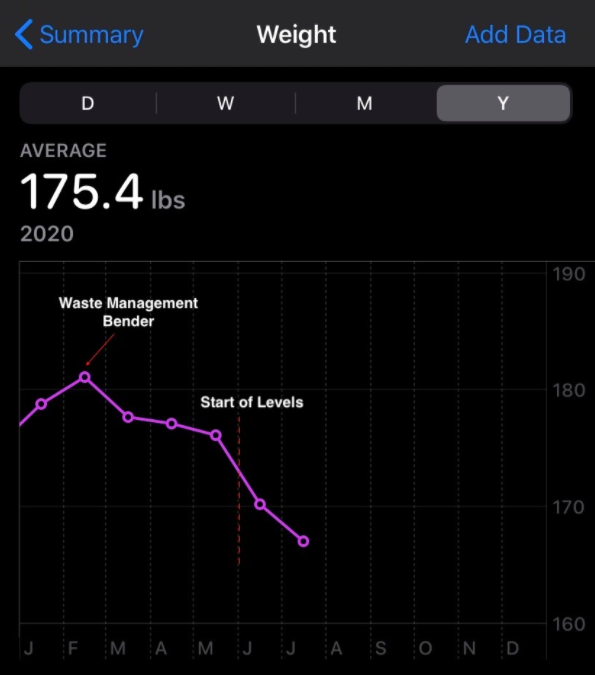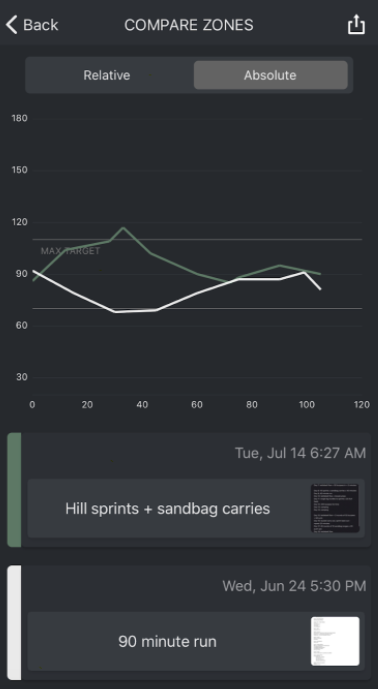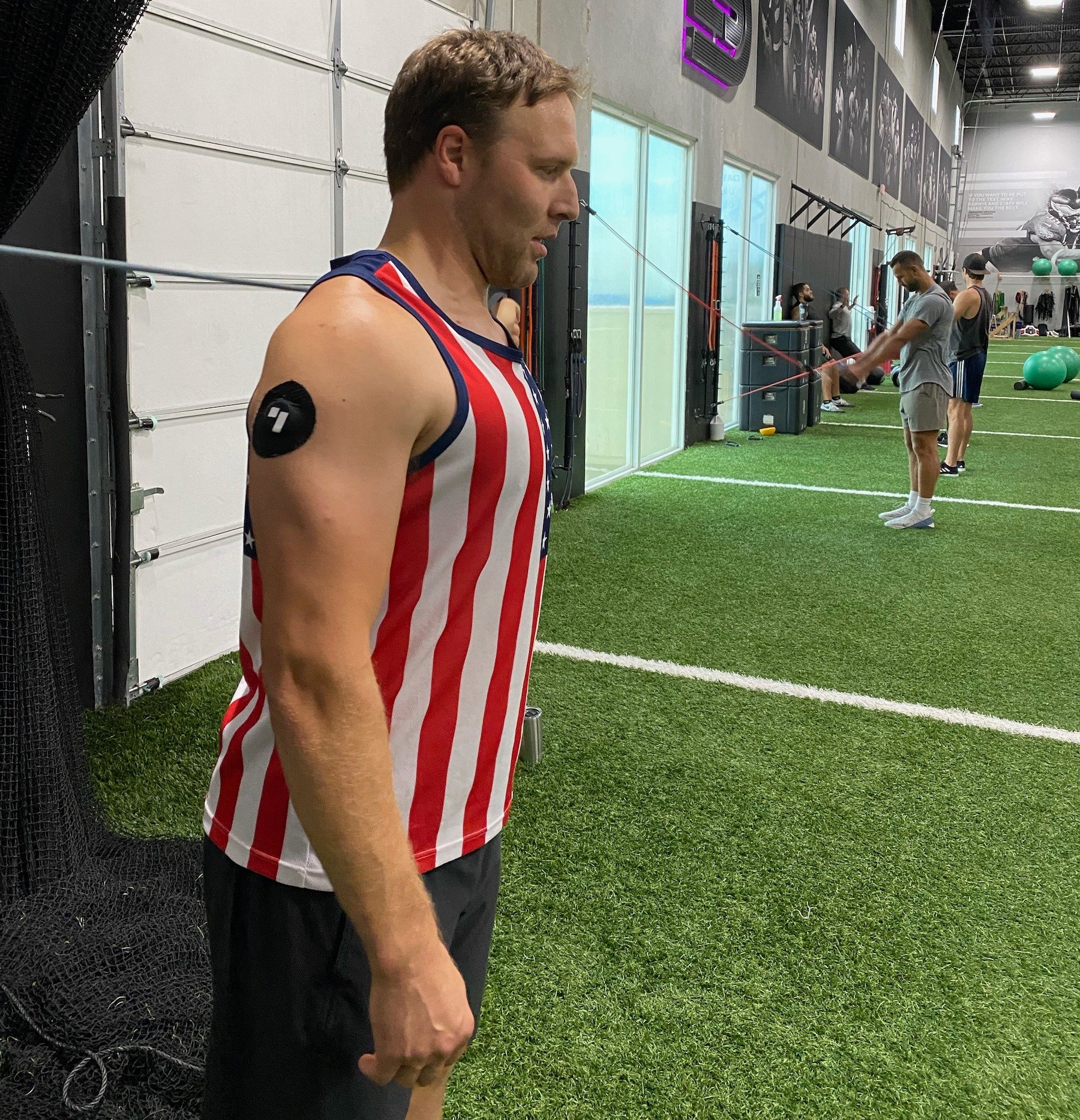“Seeing the results first-hand is such a motivating aspect,” says David Lee, a former collegiate soccer athlete and data scientist based in Seattle. “It’s like looking at the mirror and looking at the scale, that’s where the extra motivation comes from. Levels is similar in that you can see the compound effects of healthy metabolic health scores over time, and confirm the results with the good old eye test in the mirror, which pushes you to keep going.”
David Lee studied biology in college and wrote a paper about how a ketogenic diet can affect epilepsy and seizures. If keeping insulin sensitivity high and blood glucose levels low could potentially prevent these processes from happening in the brain, David wondered what other longevity benefits one could receive. He tried a strict keto diet, but as a collegiate soccer athlete always chasing better performance, he realized his athletic output requirements needed more juice.
“The objective data makes it easier to make directionally good nutritional decisions, and that makes it so much easier to be consistent without the added mental stress of calculating calories and living a rigid lifestyle because of your diet.”
David learned that a typical keto blueprint didn’t work with his sprint-heavy workout routines. He soon embarked on a mission to find a way to leverage the potential long-term benefits of keto while also getting explosive sprint energy. He started following people like Tim Ferris, Peter Attia, Dom D’Agostino, and others who were experimenting with CGMs.
“In January 2020, I did a DEXA scan that put me at 18.5% body fat,” notes David. “I was spending a lot of time at work and eating liberally, and decided to make a big health push. I started using Levels around June 2020 to refine my understanding of nutrition. I dropped about 13 pounds in about two months, and being able to visualize the metabolic journey with Levels was insightful.”

David credits the new perspective of his metabolic health as an impetus for envisioning a stronger connection between food and energy.
“I am big on using data to make informed decisions about my general wellbeing,” remarks David. “I want to have a lot of metrics to develop feedback loops that lead to actionable improvements. Levels helped me summarize a very important component of my biochemical profile. The objective data is great to connect perspective and personal performance to drive actionable insights.
Metabolic Health as a Keystone Habit
For David, the best metabolic health approach is to build a flexible set of habits built on short feedback loops based on data, rather than a rigid pass-or-fail goal tracking system.
“As a data scientist, I try to view all data as being part of a system. I think a lot about systems and habits,” says David. “If you have good habits and a finely-tuned autopilot system, you’ll directionally be pretty good. Levels helped me get that instant feedback loop and hone in on my habits and make sure I was going in the right direction.”
Being directionally correct has allowed David to eliminate the extra worry that may come with optimizing his personal nutrition so he can focus on stringing together positive days.
“James Clear’s book Atomic Habits helped me bring a lot more awareness to the actions I was taking on a daily basis, particularly how I could rewire my days around a certain keystone habit,” believes David. “If you set metabolic health as your keystone habit, you’ll end up driving much more awareness and accountability to every other aspect of your life: sleep, exercise, nutrition, stress, and so on. Before you know it, you’re stacking other healthy and beneficial activities together while attempting to optimize your metabolic health score in the app.”
However, building habits can be difficult if they come with the responsibilities of tedious rote work such as manually logging food and exercise, and then trying to correlate it with an additional response data set, such as blood glucose.
“What I liked the most about Levels is that it helped make eating healthy and making good choices less neurotic,” comments David. “Snapping a picture of your meal is so easy– otherwise I would hate logging anything because it’s just tedious. Even logging workouts is tedious. I set up templates for these things because individual logging is so annoying.”
The nuances of nutrition can be tricky to nail down without a real-time cause and effect. David had a functional understanding of how what types of foods were good for him in theory, and seeing his metabolic data helped him develop a more granular understanding.
“Prior to tracking my metabolic health, I basically just relied on intuition,” says David. “One of the most significant eye-openers was the impact white rice and white flour could have on me. Whether it was enchiladas or sushi, or anything that was white rice based, I would spike up. So now, I plan to have that at the end of the week or before or after a really hard workout.”
As long as he was eating directionally good, David found a delayed gratification piggy-bank effect on his metabolic health.
“I could have a cheat meal with minimal metabolic impact because I had basically built some sort of credit with my body, explains David. “Recently, I had a Blizzard from DQ and it didn’t do much, whereas maybe if I had like two bad days in a row, my glucose levels would have probably exploded.”
Optimizing Workout Strategy
David is very principled and strategic about his workout routines and nutrition. He found that by reducing the cognitive load of deciding his workouts and nutrition, he was able to focus more on how he can better optimize his athletic endeavors by prioritizing his metabolic health.
“I liked seeing which things are working well, which ones aren’t,” says David. “With Levels, right away, I was able to see validation that I ate well. Seeing those green metabolic health scores drove my other behavior. It became easier to connect data sets. I noticed that if I had a great workout one day, I also tended to have a green metabolic score– I also felt overall better and more accomplished on that front. I focused on making life decisions that gave me better metabolic health scores because they were linked to overall positive results in many other aspects of my life.”
Being able to see a single objective data makes it easier to quantify subjectivity. If we can ascertain a positive impact from our actions on our overall well being, we’re able to focus on the things that give us more long-term enjoyment in life.
“I found that having accessible metabolic data just makes you a more conscious and thoughtful eater,” concludes David. “It also gives you a ton of flexibility. For example, if I’m about to eat something I’d consider bad for me, I better enjoy it because it’s going to bomb the score. Better yet, I can plan to take actions after something that spikes me to minimize the negative impact while also getting a stronger burst of energy.”
Planning his daily workouts in one sitting a month in advance, David found that he was able to reduce the daily requirements of deciding what to eat and how to work out.
“The first thing I did when I woke up was check my workout and be locked into it,” comments David, “That would roll into the rest of my day’s nutrition. I would pair my meal types with my workouts. I found this reduces the necessity to think of it on a daily basis, and I think it created a really good synergy of accountability to yourself.”
In action, David found that he could coordinate his meals with his type of workout to maximize his athletic output and set reasonable expectations.
“I tried to monitor how HIIT versus low-intensity longer duration exercise impacted my glucose levels,” explains David. “If I was doing HIIT exercises like sprints, I wanted to see that big spike. If I was doing long runs, I’d look for my levels to be fairly flat. If I saw myself crashing, I would eat foods to replenish my glycogen. This all connects to my daily nutrition and planned workout as well.”

“The objective data makes it easier to make directionally good nutritional decisions, and that makes it so much easier to be consistent without the added mental stress of calculating calories and living a rigid lifestyle because of your diet.”
By using the Zone Comparison feature in Levels, he could see how his HIIT versus longer-duration impacted his energy levels, and that information influenced how he would eat before, during, and after a meal.
“If I didn’t see a big spike in my HIIT exercises, I felt that I probably could have ran a little bit harder, or that I should have done the exercise with more effort or giving myself a shorter break. I wanted to see that large spike, I wanted to be huffing and puffing. I wanted to visualize the glucose being broken down. If it was a longer-duration exercise, like a 90-minute run, I expected to see a long and slow breakdown.”
Final Thoughts: Directionally Good Metabolic Health
David Lee is on a mission to feel better and live longer, and he’s found that by focusing on his metabolic health and setting the goal of being directionally good, achieving his other goals becomes much easier.
“My nutrition plan is simple now and picking food is so much easier now: these are the foods that make me feel good, hopefully I can cook them well so they taste good too, and these are the meals that make me feel bad,” laughs David. “Instead of having to do a lot of the manual labor these insights would usually require, I can build a real-time awareness of where my metabolic health is at any given moment.”
Without the immediate response, David posits, he would end up trying to retroactively piece together meaning over weeks and months. The shorter the feedback loop, the easier it is to focus on making improvements rather than just monitoring and logging.
“Metabolic health and overall wellness go hand in hand,” comments David. “At the end of the day, it becomes much easier to stack good days together in a row versus trying to set a vague long-term goal over a period of weeks or months. Having that feedback loop makes it so much to stack good habits together, which leads to more good days.”









